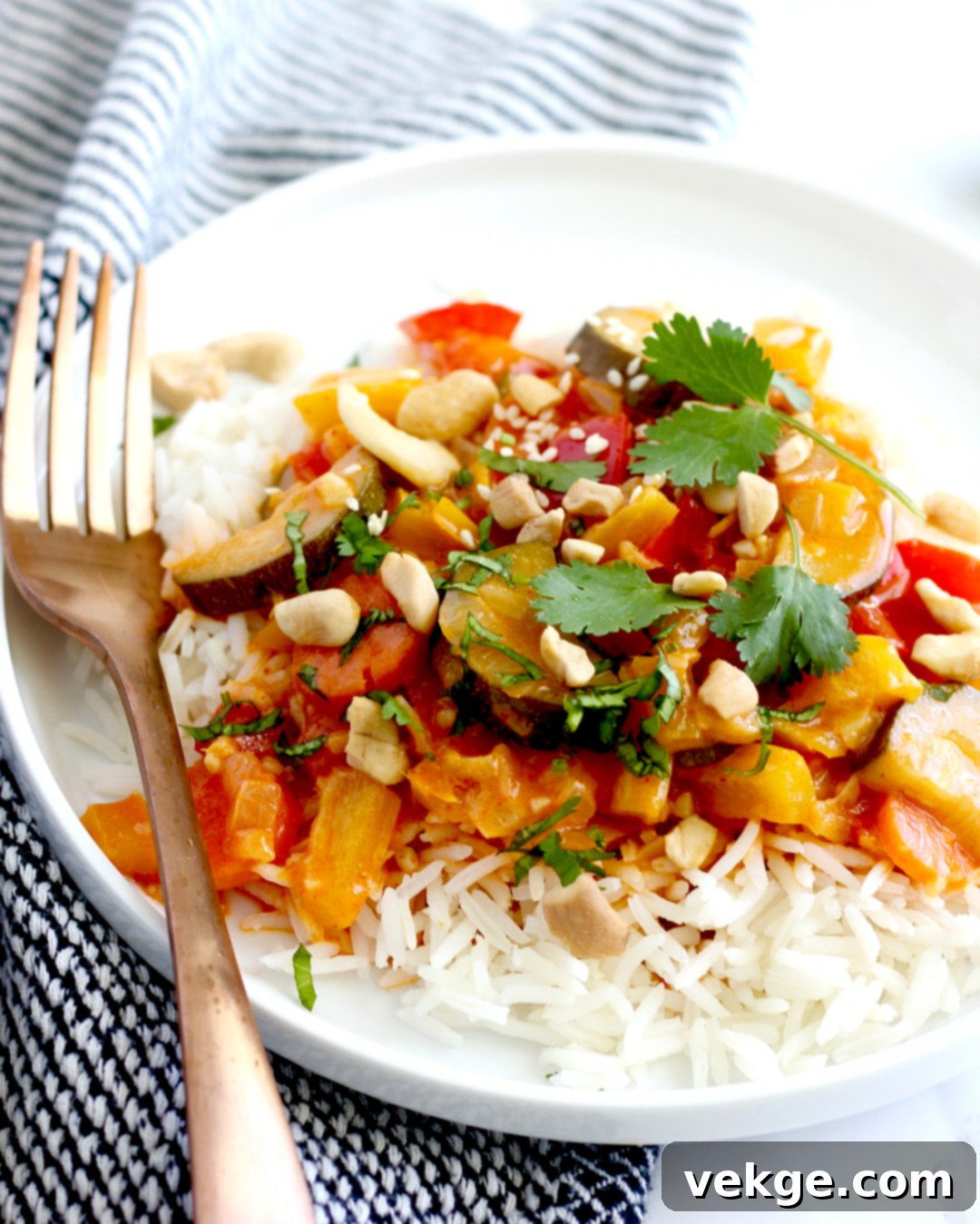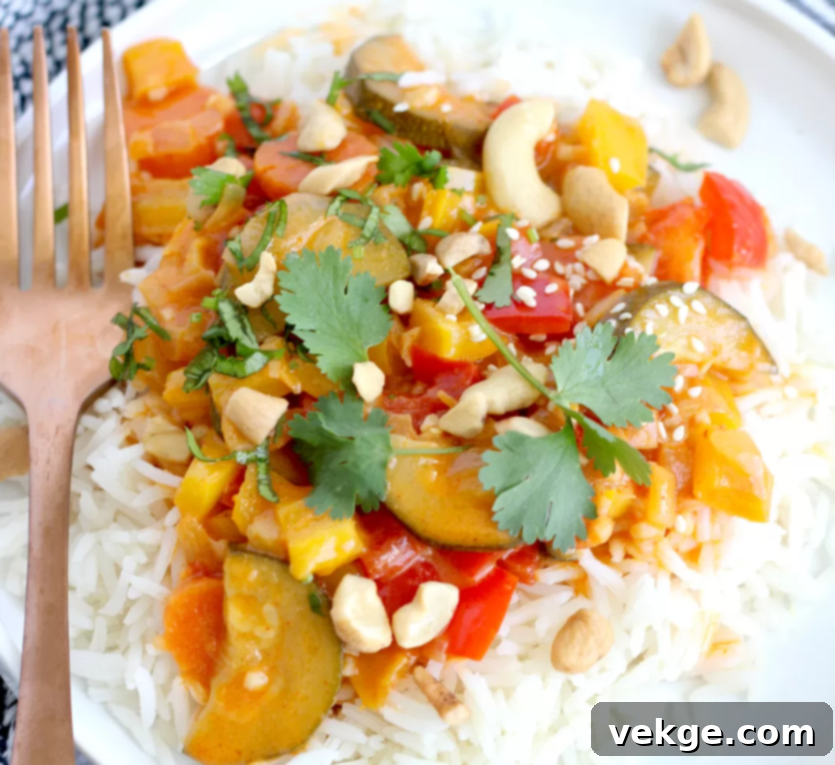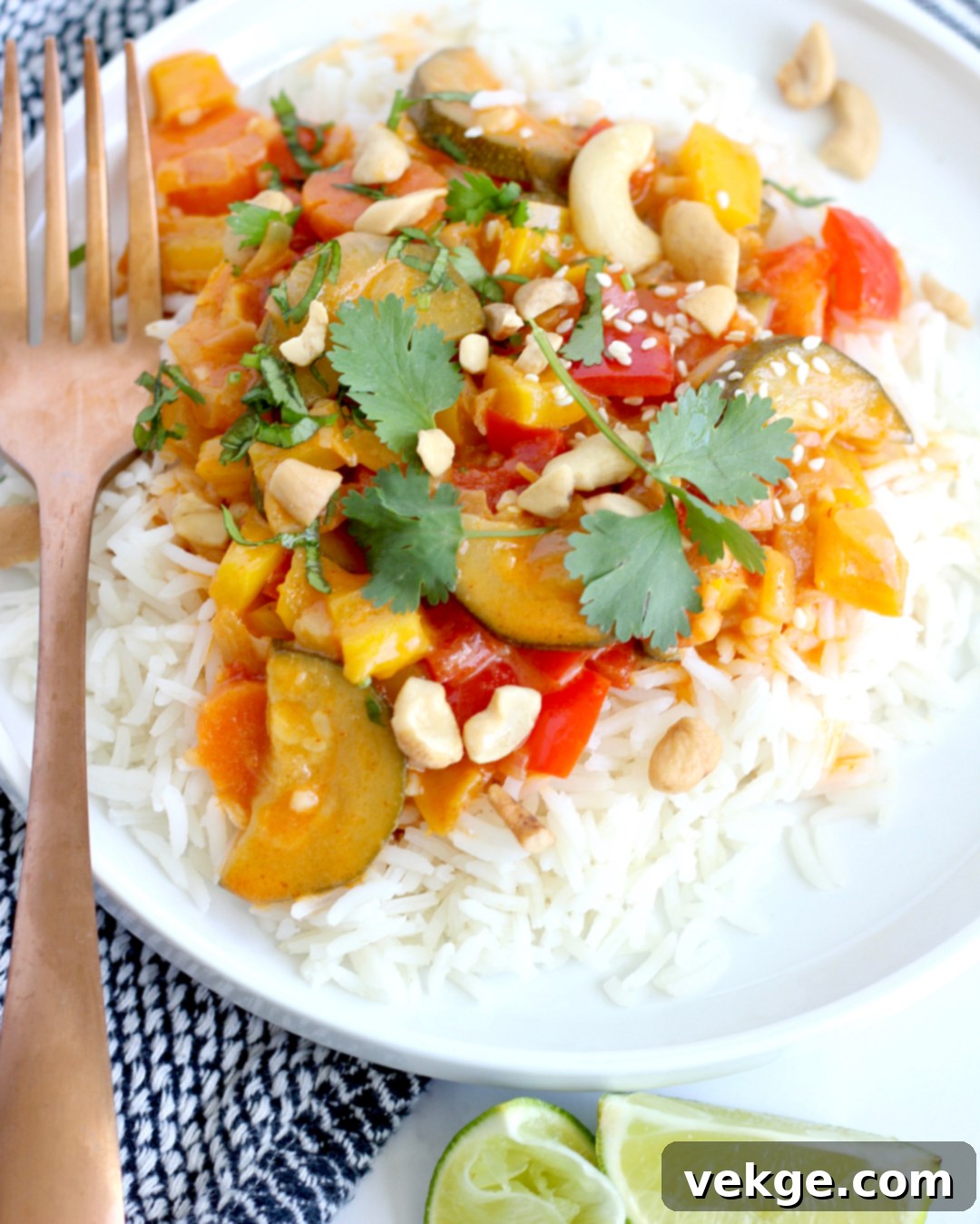Hearty & Flavorful Thai Red Curry with Vegetables: A Plant-Based Delight
Embark on a culinary journey to Thailand from the comfort of your kitchen with this incredible Thai Red Curry with Vegetables. This dish is a vibrant testament to the power of plant-based cooking, proving that “meatless” can still mean incredibly hearty, deeply satisfying, and bursting with flavor. Far from being overly spicy, our recipe offers a rich depth of taste with a delightful hint of natural sweetness, making it a crowd-pleaser for all palates. Imagine serving this aromatic curry over fluffy basmati rice, adorned with a sprinkle of crunchy cashews – pure bliss! It’s a meal that rivals your favorite Thai restaurant experience, delivering authentic flavors and a cozy warmth in every spoonful.

Unlocking the Magic of Thai Red Curry
Thai cuisine is renowned for its intricate balance of sweet, sour, salty, and spicy flavors, and red curry is a shining example. What makes this particular red curry so special is its vegetarian nature, which doesn’t compromise on the robust flavors typically associated with Thai dishes. The foundation of this curry lies in a high-quality red curry paste, a blend of red chilies, lemongrass, galangal, kaffir lime zest, and other aromatic spices. When combined with creamy coconut milk, it transforms into a rich, luscious sauce that coats every vegetable beautifully.
This recipe celebrates the versatility of vegetables. While we’ve outlined a fantastic combination, the beauty of this dish is its adaptability. Feel free to incorporate your favorite seasonal produce. Think about adding cubes of sweet potatoes or butternut squash for extra sweetness and texture, hearty kale or spinach for a boost of greens, or even crisp celery for an added crunch. The key is to be mindful of varying cooking times; root vegetables will need a longer simmer, while leafy greens can be added towards the end. What truly sets this particular recipe apart is its genuinely mild and creamy sweetness – absolutely no overwhelming heat, just pure, comforting flavor. The sauce is so wonderfully rich and smooth, you might even find yourself wanting to enjoy it as a comforting soup!

Why Choose a Plant-Based Thai Red Curry?
Opting for a vegetarian Thai red curry is a fantastic choice for both your health and your palate. Packed with a diverse range of vegetables, this dish provides an abundance of essential vitamins, minerals, and dietary fiber. It’s naturally cholesterol-free and lower in saturated fats compared to meat-based curries, especially when made with a moderate amount of coconut oil. Furthermore, incorporating more plant-based meals into your diet is a sustainable choice, contributing to a healthier planet.
Beyond the health benefits, this curry is incredibly satisfying. The creamy texture of the coconut milk combined with the hearty vegetables creates a fulfilling meal that leaves you feeling nourished and content without the heaviness of meat. It’s also a perfect canvas for culinary creativity, allowing you to experiment with different vegetable combinations to suit your taste and what’s available in your fridge. Whether you’re a seasoned vegetarian or simply looking to incorporate more delicious plant-forward dishes into your routine, this Thai Red Curry is an excellent place to start.

Thai Red Curry With Vegetables
Print
Pin
Rate
Main Dishes
7 minutes
15 minutes
Ingredients
- 1-2 Tbsp coconut oil
- 1 cup diced white or yellow onion
- 1 large carrot, peeled and sliced into rounds or half-moons
- 1 yellow bell pepper chopped into bite-sized pieces
- 1 red bell pepper chopped into bite-sized pieces
- 2-3 cloves garlic, minced (or 1 tsp garlic paste)
- 2 Tbsp fresh minced ginger
- 1 medium zucchini, sliced into half-moons or rounds
- 2 heaping Tbsp of Thai Red Curry Paste (adjust to taste for desired mildness/spice)
- 1 can full-fat coconut milk (13.5 oz / 400ml)
- 1/3 cup water or vegetable broth
- 1 Tbsp soy sauce (or tamari for gluten-free)
- 1 Tbsp rice vinegar
- 1 Tbsp brown sugar (or maple syrup for refined sugar-free)
- Salt and freshly ground black pepper to taste
- Optional garnishes: roasted cashews, fresh lime juice, chopped fresh cilantro, sesame seeds
- Cooked basmati rice, for serving
Instructions
- In a large, deep saucepan or Dutch oven, heat the coconut oil over medium-high heat. Add the diced onion, bell peppers (red and yellow), and sliced carrots. Sauté these vegetables, stirring frequently, for about 5-7 minutes, until they begin to soften but still retain a slight crispness. This step helps to build the flavor base for your curry.
- Next, add the minced garlic, fresh minced ginger, and sliced zucchini to the pan. Continue to cook and stir for another 2-3 minutes, allowing the aromatic flavors to develop and the zucchini to start tenderizing. Season lightly with a sprinkle of salt at this stage to enhance the natural flavors of the vegetables.
- Stir in the Thai red curry paste. Cook for 1 minute, pressing the paste into the vegetables to lightly toast it. This step is crucial for releasing its full aromatic potential and deepening the overall flavor of your curry. Be careful not to burn it.
- Pour in the full-fat coconut milk, water (or vegetable broth), brown sugar, rice vinegar, and soy sauce. Stir everything together thoroughly to ensure the curry paste is fully incorporated into the liquid. Bring the mixture to a gentle simmer, then reduce the heat to medium-low. Let it simmer, stirring occasionally, for approximately 5-7 minutes. This simmering time allows all the vegetables to become perfectly tender and the sauce to thicken slightly to a beautiful, rich consistency. Taste and adjust seasonings if necessary, adding more salt, sugar, or vinegar to achieve your preferred balance.
- Serve your vibrant Thai Red Curry immediately over freshly cooked basmati rice. For an extra layer of texture and flavor, garnish generously with roasted cashews – a personal favorite! If you’re looking to elevate the dish further, a squeeze of fresh lime juice and a sprinkle of chopped fresh cilantro add a wonderful brightness. For an even more authentic touch, a dash of sesame seeds can be added. Enjoy this delightful and comforting meal!
Tips for the Perfect Vegetarian Thai Red Curry
Choosing Your Curry Paste:
The quality of your red curry paste significantly impacts the final taste. Look for authentic Thai brands, often found in Asian grocery stores or the international aisle of larger supermarkets. Some brands can be quite spicy, so if you prefer a milder curry, start with a smaller amount and add more to taste. Conversely, if you enjoy more heat, feel free to add an extra tablespoon or even a dash of chili flakes.
Vegetable Versatility:
Don’t be afraid to experiment with other vegetables! Broccoli florets, snap peas, green beans, bamboo shoots, mushrooms, and even chunks of pineapple can make excellent additions. For firmer vegetables like sweet potatoes or carrots, ensure they are cut into smaller, uniform pieces to cook evenly and add them earlier in the sautéing process. Leafy greens like spinach or bok choy should be stirred in during the last few minutes of simmering to prevent overcooking.
The Creaminess Factor:
Using full-fat coconut milk is essential for achieving that rich, creamy texture and authentic flavor. Lite coconut milk will result in a thinner, less satisfying sauce. If you want an even richer curry, you can use a bit of the coconut cream from the top of the can without shaking it, and then add the rest of the milk.
Flavor Balance is Key:
Thai cuisine is all about balance. The brown sugar provides sweetness, the rice vinegar offers a tangy counterpoint, and the soy sauce (or fish sauce if you’re not strictly vegetarian/vegan) adds umami and saltiness. Always taste your curry before serving and adjust these elements. A squeeze of fresh lime juice at the end can brighten all the flavors.
Serving Suggestions & Variations
While basmati rice is a classic accompaniment, this curry is equally delicious with jasmine rice, brown rice, or even quinoa for a gluten-free and protein-rich option. For those who enjoy bread, a side of warm naan or roti would be delightful for soaking up every last drop of the exquisite sauce.
Consider enhancing this dish with additional protein if desired. Cubes of pan-fried tofu or tempeh absorb the curry flavors beautifully and add more substance. For a burst of freshness, a scattering of Thai basil leaves at the very end can introduce a lovely aromatic note that complements the red curry paste.
Storing and Reheating
This Thai Red Curry makes fantastic leftovers! Store any uneaten portions in an airtight container in the refrigerator for up to 3-4 days. To reheat, gently warm the curry on the stovetop over medium-low heat, stirring occasionally, until heated through. If the sauce has thickened too much, you can add a splash of water or vegetable broth to reach your desired consistency. The flavors often deepen and meld even more wonderfully after a day or two, making it a great meal prep option.
Embrace the Flavors of Thailand
This vegetarian Thai Red Curry with Vegetables is more than just a meal; it’s an experience. It’s a harmonious blend of textures and tastes, proving that a plant-based dish can be both incredibly satisfying and profoundly delicious. With its vibrant colors, aromatic spices, and creamy sauce, it’s bound to become a favorite in your culinary repertoire. So gather your ingredients, follow these simple steps, and prepare to delight your senses with this amazing Thai masterpiece!
